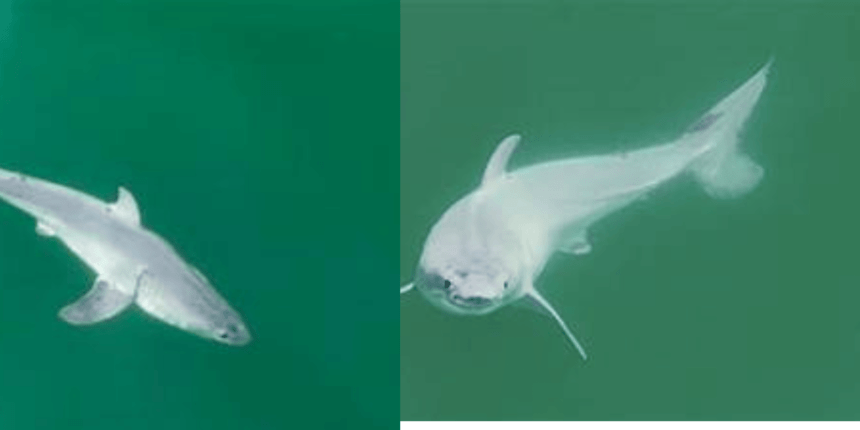Dive into the depths of the ocean’s secrets as wildlife photographer Carlos Gona captures a rare event – the albino Great White Shark Birth. Explore the groundbreaking discovery and its significance for vulnerable species. Join the journey of revealing the hidden life of sharks, shedding light on their mysterious activities. A must-watch for marine enthusiasts and conservation advocates.
The mighty Great White Sharks are among the top predators in the vast expanse of the ocean, but a crucial aspect of their existence has never been recorded or witnessed until now. For the first time, there’s speculation about a legendary albino Great White Shark, suggesting that it was captured on camera immediately after its birth.
Wildlife photographer and videographer Carlos Gona, after spending hours filming sharks, has embarked on a mission he calls “revealing the secret life of sharks.” He expressed the desire to tell a story about what sharks do when we’re not watching, not interacting with them, and not touching them. According to him, some sharks engage in mysterious activities, things with no clear explanations. “You never know what you’re going to see.”
When Gona set out last July 9th, he had no idea what to expect. After observing sharks for three years off the coast of Santa Barbara, he claimed to have encountered a “real big shark” during a particular month.
“It’s always feeding or mating or something,” he said. “They are here for some reason.”


The birthing habits of great whites remain largely unknown to the scientific community. Researchers have observed that the gestation period for shark pregnancies is over a year, and female sharks typically give birth to two to ten pups at a time. Shark pups are ovoviviparous, meaning their eggs develop inside their bodies, but they hatch and emerge alive later.
Gona initially suspected that sharks might be giving birth in the area. However, when he brought this to scientists, he was mostly told that white sharks give birth only in deep waters. But using the last battery in his drone, he and his fellow University of California, Riverside biology doctoral student, Felipe Estrada, saw a “big, big shark going down” from about 1,000 feet above the coast.
“Just a few minutes later, this little thing comes out of there,” he recounted. “At first, I thought it could be almost a 5-foot-long, almost pure white albino shark – a real, real small thing compared to all the other sharks.”
He then played the video back and saw a white film shark swimming downward.
“In my mind, there were profanities like, ‘Oh my God, I think this could be unprecedented,'” he said. In a press release, he further explained, “Dead pregnant mothers have been found with dead albino shark fetuses inside them. But this is not the case.”
Some scientists suggested that what they saw might have been the early stages of a condition, but Gona – whose findings were peer-reviewed and published in the Journal of Environmental Biology of Fishes – believes they witnessed a previously undocumented intrauterine leucism, a condition that produces a “leopard-like pigmentation” for nutrition.
He also noted that the size and shape of the shark, along with the fact that a pregnant shark had been spotted in the area before, indicated it was a newborn. The shark was almost five feet long – a size considered small for newborn great whites – and had a small, round dorsal fin.
“I’m not just seeing how the skin breaks down,” he said. “Looking at the size of the shark, looking at that unique roundness of the dorsal fin – they cannot give birth to a dorsal fin that’s straight and long, straight and pointed. To get out, they need to be round.”
Gona suggested that capturing live births in any species is rare because “it’s so unexpected.” While searching for albino sharks is not the “holy grail” of shark science, as they do not give birth themselves, he believes it is an “important part” that can help researchers reach their goal.
It is particularly crucial for great white sharks, as this species is considered vulnerable t


o extinction and listed as a threatened species by the International Union for Conservation of Nature. Gona noted that filming in the ocean is one of the toughest tasks on the planet. “We’ve always believed it’s deep, it’s offshore. That’s why I think it’s crucial to maybe start looking closely. The coast.”
For Gona, the research is far from over. His fascination with sharks began at the age of five when he had a toy shark with which he bathed. Over the years, he has witnessed animals endure visible harm, including boat collisions and fishing during the seasons. At one point, he even filmed a dead great white with “a rope around its mouth and hooks pulled out” – the same place where he filmed the albino.
Gona said that more research and conservation efforts are needed for marine life, emphasizing the importance of studying these “mysterious, peaceful, and accounting creatures” that are fascinating to the scientific community.
“It should be considered crucial for any species to consider any nursery,” he said. “… We’ll go back and see if we can catch it again.”








